Oil More Dense Than Water
Lesson Overview for Teachers
View the video below to meet what you lot and your students will practise in this lesson.
Objective
Students volition be able to explain that the density of a liquid has to do with how heavy it is for the sample size. Students will also be able to explain that if a liquid is more dense than h2o, it volition sink when added to h2o, and if information technology is less dense than water, it volition float.
Key Concepts
- A liquid, just like a solid, has its ain feature density.
- The density of a liquid is a measure of how heavy it is for the amount measured. If you counterbalance equal amounts or volumes of ii dissimilar liquids, the liquid that weighs more is more than dense.
- If a liquid that is less dense than water is gently added to the surface of the water, it will float on the water. If a liquid that is more dense than h2o is added to the surface of the water, it will sink.
Notation: We are purposely using the terms "size" and "amount" instead of "volume" in this lesson about density. Nosotros are also using "heavy", "light", and "weight" instead of "mass". If your students accept already learned the meanings of volume and mass, you tin can easily use those terms to define density (Density = mass/book), and and then use those terms in this lesson.
NGSS Alignment
- NGSS 5-PS1-3:Make observations and measurements to identify materials based on their properties.
Summary
In the previous lesson, students learned that density has to exercise with how heavy an object or substance is relative to its size, and that density determines whether an object sinks or floats. Students also observed that you tin compare the density of a substance to the density of h2o past comparing the weights of equal amounts of the substance and h2o using a remainder.
In this lesson:
- Every bit a demonstration, the instructor will compare the weight of an equal amount or volume of h2o and corn syrup and then students can observe that corn syrup is more dense than water and sinks.
- Students will compare the weight of an equal amount or volume of water and vegetable oil and run into that vegetable oil is less dense than water and floats.
- Students add corn syrup to layered oil and water and meet the corn syrup sinks below both the oil and water.
Evaluation
Download the pupil activity sheet (PDF) and distribute ane per student when specified in the activity. The activity sheet volition serve every bit the Evaluate component of the 5-E lesson plan.
Safety
Brand sure you and your students wear properly plumbing equipment safety goggles. Isopropyl "rubbing" alcohol is a flammable liquid. Keep away from estrus, sparks, open flames, and hot surfaces. Isopropyl alcohol is besides irritating to eyes and peel, and may crusade drowsiness or dizziness if inhaled. Work with isopropyl alcohol in a well-ventilated room. Read and follow all warnings on the label.
Clean-up and Disposal
Remind students to launder their hands after completing the activity. All common household or classroom materials can be saved or disposed of in the usual manner.
Materials
- Water
- two Clear plastic cups
- Corn syrup (Karo syrup), 1 cup
- Food coloring
- Popsicle stick or plastic spoon
- Vegetable oil
- Isopropyl "rubbing" booze (70%)
- Ice cubes
- Balance
Teacher Preparation
Cascade 50 mL of corn syrup, fifty mL of h2o, and fifty mL of vegetable oil into 3 plastic cups for each group.
Notation: Corn syrup and vegetable oil tin can be difficult to clean out of graduated cylinders. To avoid this mess, measure and pour 50 mL of water into each of three plastic cups. So marking the outside of each loving cup to indicate the level of the liquid in each cup. Pour out the water from two of the cups and dry out the within with a newspaper towel. Next, utilize those cups to measure the amount of corn syrup and vegetable oil for each group. Add one drop of nutrient coloring to the corn syrup.
Each group will demand 50 mL of corn syrup, fifty mL of water, and 50 mL of vegetable oil in split cups.
For the demonstration, you lot will need 50mL of h2o and fifty mL of corn syrup (colored with 1 drop of food coloring) in separate cups.
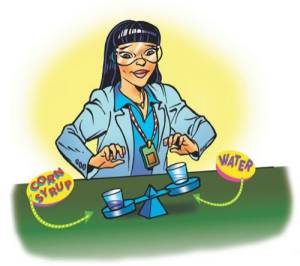
Engage
ane. Exercise a sit-in to compare the density of corn syrup and water.
Materials for the demonstration:
- Water in a clear plastic cup
- ¼ cup corn syrup (Karo syrup) with nutrient coloring in a clear plastic cup
- Popsicle stick or plastic spoon
- Graduated cylinder or beaker
- Balance
Procedure
- Concur up two cups and tell students that you have water in one cup and the same amount or book of corn syrup (colored blue) in the other loving cup.
- Place the cups on reverse ends of a residue.
Expected results
The corn syrup is heavier, which shows that it is more than dense than h2o.
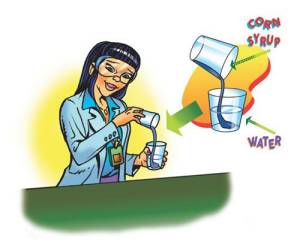
Ask students:
- Since we weighed equal amounts and the corn syrup was heavier, is water or corn syrup more dumbo?
Corn syrup is more dense than water.
- Predict what will happen if we pour the corn syrup into the h2o. Will the corn syrup float or sink when added to the h2o?
The corn syrup should sink in the h2o.
- Pour the colored corn syrup into the cup containing water to see if the corn syrup floats or sinks in the water.
Expected result
It volition sink. The corn syrup sinks in the water.
Give each pupil an Activity Sheet (PDF).
Students will record their observations, and reply questions about the action on the activity sheet.
Explore
two. Have students compare equal volumes of h2o and vegetable oil and test whether the oil floats or sinks when added to water.
Question to investigate: Is vegetable oil more or less dense than water?
Materials for each grouping
- l mL of water in cup
- 50 mL of vegetable oil in cup
- fifty mL of corn syrup in cup
- Balance
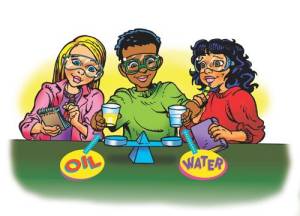
Procedure
- Place the cups of water and vegetable oil on opposite ends
Expected results:
The oil weighs less (is lighter) than an equal volume of h2o.
Ask students:
- Which is less dumbo, water or vegetable oil?
The vegetable oil is less dumbo than water because information technology weighs less than an equal volume of h2o.
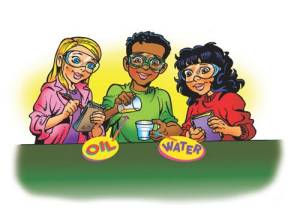
- Predict what will happen when you pour the vegetable oil into the water. Will the oil sink or float?
The oil will bladder on the water.
- Pour the vegetable oil onto the water to see if it sinks or floats.
Expected results:
The oil floats in a separate layer on the water.
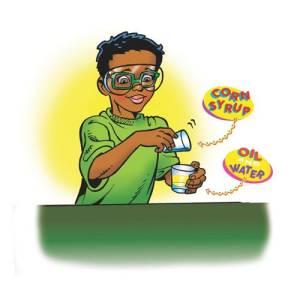
iii. Have students pour colored corn syrup into the oil and h2o.
Explain to students that that they take discovered that vegetable oil is less dense than water, and that the corn syrup is more dense than water.
In i manus, hold up a loving cup containing vegetable oil floating on water, and in the other paw, hold up a cup containing colored corn syrup.
Ask students:
- Predict what will happen if you lot pour the corn syrup into the vegetable oil and water.
The corn syrup should sink to the lesser because information technology is the most dumbo.
- Pour the corn syrup into the cup with oil floating on water.
Expected results
The corn syrup will sink through the oil and water resulting in 3 distinct layers in the loving cup. There will be oil on superlative, water in the middle, and corn syrup on the bottom.
Explicate
4. Utilise an animation to review and explicate educatee observations.
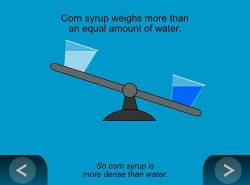
Show the Blitheness Density of Liquids.
Explain that to compare the density of corn syrup and water you tin can compare the weight of equal volumes of water and corn syrup. Since the same book of corn syrup is heavier than water, information technology is more dense and sinks in water. Explicate that to compare the density of oil and water you need to compare the weight of equal volumes of h2o and oil. Since the oil is lighter, it is less dense than water and floats on water.
Extend
five. Do a demonstration to compare the density of water and isopropyl alcohol.
Materials for the demonstration
- 2 clear plastic cups
- Water
- Isopropyl "rubbing" alcohol (70%)
- 2 ice cubes
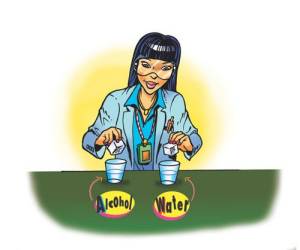
Procedure
- Label i loving cup Water and the other Alcohol. Cascade water and isopropyl alcohol into their labeled cups until each is about ½ full.
Show students the two liquids and bespeak out that they look very like. - As students watch, identify an ice cube in each liquid.
Expected results
An ice cube floats in water but sinks in alcohol.
Ask students:
- Exercise you lot call up water and isopropyl alcohol have the same density or different densities?
The liquids must take different densities because the water ice cube floats in one simply sinks in the other.
Explicate that since ice floats in h2o, liquid water must be more dumbo than ice. Since ice sinks in isopropyl alcohol, alcohol must exist less dense than water ice. This means that water and isopropyl alcohol must have dissimilar densities and that the h2o is more dense than isopropyl alcohol.
You could cheque this by comparing the mass of 50 mL of water and l mL of isopropyl alcohol on a balance.
Expected results
The h2o will weigh more than the same volume of isopropyl booze (but non by much).
Oil More Dense Than Water,
Source: https://www.acs.org/content/acs/en/education/resources/k-8/inquiryinaction/fifth-grade/substances-have-characteristic-properties/density-of-liquids.html
Posted by: cobbalkinst.blogspot.com


0 Response to "Oil More Dense Than Water"
Post a Comment